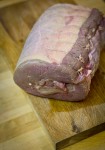Venison Christmas dinner, and the best leftovers ever…
 The centrepiece of our Christmas dinner this year was a roasted leg of venison. Pretty good as it stands (ahem), but curiously, this tale ends up being all about the leftovers: the venison pie afterwards stole the show!
The centrepiece of our Christmas dinner this year was a roasted leg of venison. Pretty good as it stands (ahem), but curiously, this tale ends up being all about the leftovers: the venison pie afterwards stole the show!

My girlfriend’s family had served the roast venison a couple of Christmasses before, but it had overcooked disappointingly. I was given the challenge/opportunity to see if I could do it better. The roast recipe (see photo below) is from the Tatton Park estate, and I was handed a photocopy, complete with annotations. Now I like a good bit of venison, but hadn’t cooked a joint this size before, and was aware it’d need a bloody good basting to keep it tender. Hardly the hassle-free roast which is recommended for a peaceful Christmas Day, especially the first cooking for the in-laws!

I ordered the meat from Paul in the market (asking him to leave me the bone), and started work on Christmas Eve by making a stock … roasting the bones for 30mins before boiling up with a mirepoix and some herbs for a hour or so, until the stock tasted rich, robust and savoury. Venison’s very lean, but this yielded a creamy covering of fat, which I reserved and reformed for later use. While the stock was bubbling I also made up a batch of spiced Eastern European-style red cabbage. It’s normally better then day after making it, and has a good tang with caraway seeds, wild honey and bramley apple.

After their experiences with the venison joint I was a little wary of following the recipe to the letter, so on Christmas Day we got cracking by late morning. This gave us time for a slow, low cooking; although potentially less than the recipe called for. After making the Stilton, bacon and panko stuffing, this got rolled up inside the joint which was then retied. I also stuck spears of that venison fat into the flesh, to help lard it. I wrapped the joint tightly in foil for all but the last 40 mins or so, when the foil covered the whole roasting tin, so the juices could really get going. All in all it was probably cooking for a shade over three hours, basted regularly. The meat rested for a half hour while I whipped up gallons of gravy, deglazing the pan with port and using the stock to build up the flavour.

After our Spiced Beef starters, our Christmas plate was finished off with hasselback potatoes, roasted parsnips, sprouts with bacon and chestnut, and sweet potato mash. A great spread, with plenty of flavour, variety and colour for the main meal. The venison was very tender and moist (phew!) and the taste was good and richly gamey, but not exceptional (admittedly this was up against the Spiced Beef, which was a real winner by any standards). We had a leftover meal on Boxing Day, with as many of the trimmings and accompaniments as our plates would hold, but we didn’t fancy eating rich slices of venison every day until New Year.

One of my Christmas presents was the OCD Chef’s Chopping Board (my friends know me too well) and I’d joked about keeping my scalpel in the kitchen with it. My inner designer feels totally at home with a scalpel blade, and I fancied building on a couple of previous attempts to decorate a game pie. With around half a kilo of cooked venison, and a gale blowing outside, pie seemed like the perfect prospect. A post-Christmas pie, made with Christmas presents, leftovers, and a nod to the frozen north…
We came home after a shorter-than-planned afternoon walk in the heavy winds – any hot port in a storm – and we threw ourselves into making the leftover ‘pie to end all pies’. Venison, stilton and gravy were all to hand. This was to be rich, rumbustious and made to revel in the excesses of the Christmas period: game, port and piggy bits, but I had a sweet potato leftover to use up. I reckoned that, much like the butternut squash in my venison pasties, this token vegetable’d work well.
I rendered down the bacon fat, and melted some butter, along with a sprig of rosemary. Then in went a few shallots, the diced bacon, and some cubes of wild boar salami, followed after a bit by cubed sweet potato and a hare stock cube. The plan was to soften everything through, cooking gently and once that was done, it all came off the heat. We discarded the stuffing from the venison, and cut the meat into properly decent-sized chunks. Venison has a tendency to firm up if overcooked, so I reckon bigger was better, and should guard against dryness. The hunky chunks of deer got mixed up well with the other cooled, cooked ingredients, then I crumbled in generous handfuls of Stilton to the mix. It looked great.
There was probably about 330ml of gravy left over from Christmas Day (a handy size… can you imagine if they sold tins of real gravy next to the Coke and Irn-Bru?) so that got warmed up in a pan, along with teaspoon of Gentleman’s Relish (the secret ingredient),

some extra hare stock cubes, a tablespoon-sized blob of redcurrant jelly, and significant quantities of ‘cooking’ port. After thickening to a wonderfully rich, thick consistency this was gently and methodically poured over the pie filling in the dish.
I’d already rolled out the pastry (Jus-Ro’s finest… I didn’t fancy making puff (or rough puff) this time) and traced around the pie dish, gathering up the offcuts to make decorations with my trusty blade. Once the pie dish was filled we had fun with the decorations! I’m really pleased by how it came out… there was no over-arching theme but I did reference my other half’s Christmassy knitwear for the reindeer inspiration. After that we got busy making trees and stars, then fitted everything together in a 3D manner. I think I went a bit too heavy with the egg wash in places, but I love the seasonal tableaux we came up with. It’s certainly raised the bar for the next pastry creation!
The finished dish got cooked for about 40mins in a medium oven: I didn’t want to overcook the filling and this was just enough to puff the pastry topping up perfectly and the contents heated to a slight bubble. By the time it came out we were almost climbing the walls with anticipation… just enough time to get the celeriac mash and a healthy portion of the spiced cabbage on the side. Oh, the smell…

And we’re talking about a full-on, revelatory moment on the first bite. Boom… a gloriously grown-up pie fest… with the tang of the stilton, the richness of the game, the sweetness of the port-laden gravy and sweet potato meltingly intimate together on a fork. Proper posh pie heaven. Big chunks of succulent meat and light pastry were so good together… I didn’t want to stop eating it. Next day the pie made a glorious re-appearance alongside some home-fried chips and peas on the side. Which, if anything, was better than the first portion, as the gravy and filling had mellowed and mixed even more. No point in dressing up the accompaniments… pie and mash, pie and chips. Dead simple, job done. Fan-bloody-tastic!

PS. Drinks during the cooking were provided by the superlative Buxton Brewery (their cracking Wild Boar making its debut next to the aptly game in the kitchen): then we washed the pie down with a suitably Nordic brew, Einstök‘s Icelandic Pale Ale. I like my ales at anytime, but a pie and a pint is a marriage made in heaven. Happy Christmas, deer!



















































